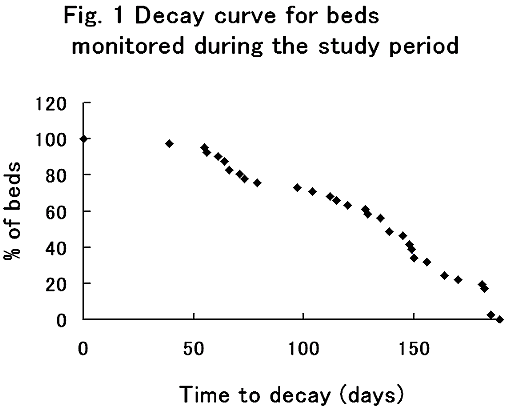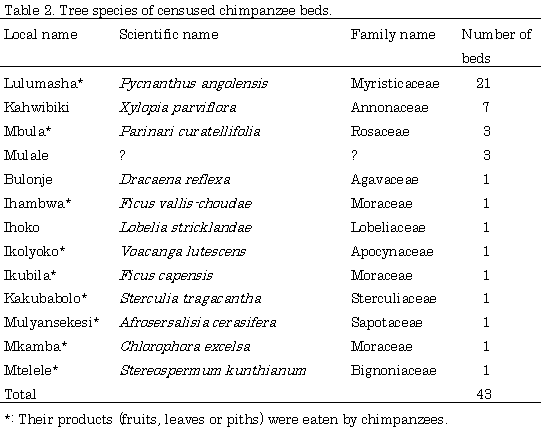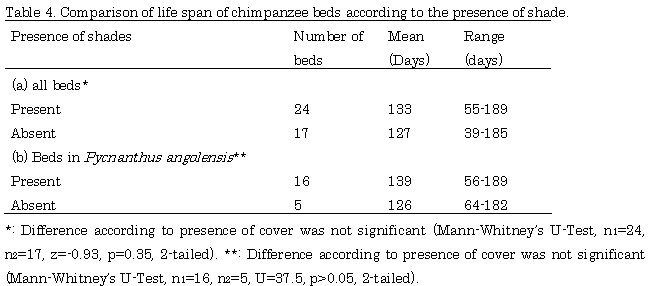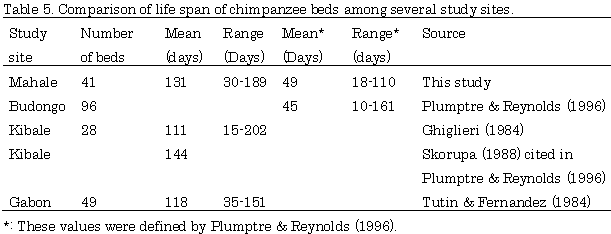|
Life Span of Chimpanzee Beds at the Mahale Mountains National Park, Tanzania.
Hiroshi Ihobe
INTRODUCTION Population estimates of wild chimpanzees have been conducted by a variety of methods. Many researchers have adopted nest- or bed-count methods to estimate chimpanzee populations due to the difficulty of making direct observations of unhabituated chimpanzees1, 2, 3, 4, 5. Ghiglieri1 developed a chimpanzee population estimation method in which some parameters, such as average life span of beds, are assumed to be different at each study site and thus not obtained simply by bed censuses. Tutin and Fernandez2 modified Ghiglieri's formula to take into account the non-random distribution of beds. However, this method also requires the average life span of beds. Hashimoto3 as well as Plumptre and Reynolds4 developed a method based on newly built beds. This method does not require average life span of beds but does require repeated censuses. Also, all three methods require presumptions such as the proportion of bed-building chimpanzees, rate of reuse of beds, and day-bed production to precisely estimate chimpanzee populations.
This paper presents the preliminary results of a study on the life span of beds at the Mahale Mountains National Park, which was made to examine the variations among the study sites.
The field work was conducted from August to December 1995. Forty-three beds constructed on known dates by habituated M group chimpanzees were monitored about once a week to determine the life span of beds. Tree species, estimated height, and the presence of shade for each bed were recorded. All of the beds monitored were constructed in August.
Age-class of beds was defined according to Tutin and Fernandez2, as shown in Table 1. I considered the life span of each bed to be the period from the date of construction to the date midway between the last weekly inspection when it was recognizable and the first when it was not.

RESULTS and DISCUSSION Out of 43 beds, two beds (4.7%) were assumed to be reused by the chimpanzees. These beds were excluded from the calculation of life span. Mean and SD of life span of 41 beds were 130.7 days and 45.7 days, respectively. The life span of beds ranged from 30 to 189 days.
Figure 1 shows a decay curve for beds monitored during the study period. Plumptre and Reynolds4 reported that the decay of beds in their study approximated an exponential decay curve, but this phenomenon was not found in this study. Plumptre and Reynolds4 suggested that the decay rate should be calculated while assuming exponential decay, since this is not likely to be greatly affected by a small number of beds that last a very long time; however, the present study did not support this assumption.

Monitored beds were usually constructed in trees, the products (fruits, leaves or piths) of which the chimpanzees fed on (Table 2). Almost half of the monitored beds were constructed in Pycnanthus angolensis trees. The M group chimpanzees frequently fed on the fruits of this tree during the study period.

The difference in mean life span of beds between two tree species (Pycnanthus angolensis and Xylopia parviflora) was not significant (Table 3). The difference in mean life span of beds among different levels of shade at the beds was also insignificant for all beds and for beds constructed in Pycnanthus angolensis trees (Table 4).


Table 5 summarizes the mean life span of chimpanzee beds at several study sites. Mean life span of beds in this study is slightly longer than that in the work of Ghiglieri1 or Tutin and Fernandez2 but slightly shorter than that of Skorupa cited in Plumptre and Reynolds4. Plumptre and Reynolds4 used a different definition of the decay of beds: if the bed had lost all of its leaves (even though dead twigs might be present), it was not counted as a bed. Using this definition, the mean life span of beds in the present study is slightly longer than that in their work. Plumptre and Reynolds4 reported that Budongo forest is drier than Kibale forest or the forests in Gabon, and thus it is likely that the leaves that formed the beds dried up and fell off more quickly. They also found that mean dry season survival time of beds was significantly shorter than mean wet season survival of beds. On the other hand, Wrogemann7 found that bed decay was significantly slower in dry seasons than in wet seasons in Gabon. McGrew, Baldwin and Tutin8 placed the Kasoje area in the next-drier position to Budongo forest on a wet-dry spectrum. Mean life span of beds in the present study is slightly longer than that in the Budongo forest. Consequently, bed decay is not affected simply by season or rainfall.

ACKNOWLEDGEMENTS The field work was financed by the Monbusho International Scientific Research Program (07041138 to Toshisada Nishida). The research was facilitated by the Tanzania Commission for Science and Technology (COSTECH), the Serengeti Wildlife Research Institute (SWRI), the Tanzania National Parks (TANAPA), the Mahale Mountains Wildlife Research Centre (MMWRC), and the Mahale Mountains National Park (MMNP). Bunde Athumani and Makelele Masayuke assisted in the census. Michael A. Huffman, Noriko Itoh, Toshisada Nishida, Kohshi Norikoshi, and Hitoshi Sasaki made contributions in the field. Fumio Fukuda and Toshimichi Nemoto helped me in various ways to complete the research. To these people and institutions, I give my deepest gratitude. REFERENCES
Back to Contents |